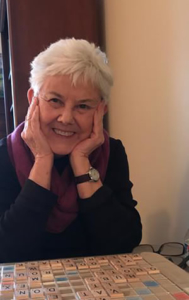
Irene Blair Honeycutt
Needing to feel grounded, I sit outside, an acorn in my hand. A slight breeze brushes my face. I loosen my grip on the acorn; and it feels lighter, as if it might mysteriously dissolve and flow into my veins.
Does this acorn hold within its DNA the tiny thing Julian of Norwich held in her palm?
A Showing from God. The size of a hazelnut. She writes, “I looked at this with the eye of my soul and thought: ‘What can this be?’” Such a small thing for her God to have made a major part of a visitation. Is it sacrilege to think that Denise Levertov is expressing both bemusement and good-natured humor when she addresses Julian in one of her dialogues: “And you ask us to turn our gaze/inside out, and see a little thing,/the size of a hazelnut,/ and believe it is our world?”
I like to think of writers conversing about life’s mysteries often evoked by small things: acorns, hazelnuts, grains of sand, flowers in crannied walls, the mustard seed. O Taste and See, Levertov says. “On the last day of the world I would want to plant a tree,” Merwin responds. “Our metaphors go on ahead of us,” Doty asserts. And if we, as poets, are receptive, we learn to follow them.
Metaphors of our poems save us, or almost do. Something beyond metaphor, beyond the poem, can only do that. Save in the sense of a “momentary stay against confusion,” Frost interjects. Poems guide, rage, console, inspire, bear witness. They reach their limits in their capacity to express the ineffable. Isn’t this why Whitman’s narrator rises in the lecture hall and leaves the astronomer lecturing? He is bored, yes. But needing more, craving more than charts and diagrams, he actually becomes sick sitting there. Is it intuition that urges him to glide out into “the mystical moist night-air” and look “up in perfect silence at the stars”? Whitman juxtaposes the expansiveness of the Great Silence of the Universe to the loud applause in the lecture hall, leaving narrator and reader feeling the mystery.
Whatever the direction, whatever form the poem takes while being shaped, whatever picture it paints, the good poem often leaves an opening for transcendence. I love how Levertov in “Some Notes on Organic Form” refers to the act of writing as a communion wherein “the writing is not a matter of one element supervising the others but of intuitive interaction between all the elements involved.”
The genesis of the poem emanates from paying attention to the world and leads to discovery. To taste and see requires the deep gaze, not the passing glance, as Levertov shows in these opening stanzas from “To Live in the Mercy of God”:
To lie back under the tallest
oldest trees. How far the stems
rise, rise
before ribs of shelter
open!
To live in the mercy of God. The complete
sentence too adequate, has no give.
Awe, not comfort. Stone, elbows of
stony wood beneath lenient
moss bed.
And awe suddenly
passing beyond itself. Becomes
a form of comfort.
Irene Blair Honeycutt’s fourth poetry book, Beneath the Bamboo Sky (Main Street Rag 2017), is sub-titled Poems and Pieces on Loss and Consolation. Her kinship with trees began in her childhood in FL where she often retreated to her palm hut. She still meets with the woods and enjoys writing time in her mountain cabin. Her work has been published by journals, including Nimrod, Southern Poetry Review, The Southern Poetry Anthology: VII, and Virginia Quarterly Review. She founded CPCC’s Sensoria. Upon her retirement from teaching, the college established a Distinguished Lectureship in her name.


 by Tina Barr
by Tina Barr